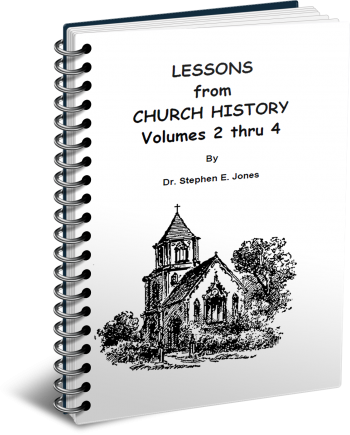Latest Posts
View the latest posts in an easy-to-read list format, with filtering options.

Volumes 2-4. This is the history of the Church from the Roman War (66-73 A.D.) to Constantine and the Council of Nicea in 325 A.D. with lessons to be learned from it.
Category - History and Prophecy

The Roman Empire reached its zenith under Hadrian, who built the famous boundary wall in the north of Britain and formally incorporated Britain into the Roman Empire. After decades of war, this was finally accomplished by treaty in 118-120 A.D. A generation later, in 139 (according to Rev. Morgan) British King Lucius was baptized by Timothy, the son of Rufus Pudens and Claudia.
In 165 A.D., Lucius became the first to proclaim Britain to be a Christian Nation about 130 years after Christ had first been introduced to the Isles. Lucius, son of Coel, (“Old King Cole”), was the great-grandson of Caractacus, whom the Emperor Claudius took captive in 52 A.D. Lucius was in turn the great-grandfather of Constantine.
One notable controversy that arose in the second century was over the proper date for the celebration of Passover. In the East, under the influence of John and Philip, the people traditionally fixed the date of Passover in the manner established by the Old Testament. They celebrated it without regard to the day of the week on the full moon (14th of Nisan, or Abib) as the law prescribed.
In the West, however, presumably following the lead of Peter and Paul, they traditionally celebrated Passover always on that Friday, because it was on Friday that Passover fell when Jesus was crucified in 33 A.D. The Passover celebrations were extended to Sunday as well, to include the time of Christ's resurrection and the feast of first fruits. This was a deviation from the law, but to them it more nearly celebrated the time and circumstance of the date of Jesus' crucifixion.
For decades, the Church remained unconcerned over these differences. But as heresies arose in the second century, and as the Church became more and more concerned with unity to ensure its survival, this dispute rose to the surface. Its importance was exaggerated because so many believed that the second coming of Christ would occur on Passover night. For this reason, the Christians were accustomed to staying up all night, even as the Israelites had done when coming out of Egypt (Ex. 12:11).
This belief elevated the importance of keeping watch on the correct date, lest they be found literally sleeping when Christ should return. It is apparent that they had not made the prophetic distinction between the two sets of feast days (Spring and Autumn). They did not realize that the Spring feasts prophesied of the first coming of Christ, while the Autumn feasts prophesied of His second coming. They were focused primarily upon the Spring feasts, for this is what was revealed to them at the time.
The heart of the controversy was whether the celebration should focus upon Christ's death (Passover) or upon His resurrection (First-fruits, or Wave-sheaf offering).
The first major summit to try to resolve this issue took place between 150 and 155 A.D. when Polycarp, bishop of Smyrna, came to Rome to discuss the issue with Anicetus, bishop of Rome. They each were armed with tradition from the apostles, and so the question was not resolved. Irenaeus later tells us the story, which is quoted by Eusebius in his Eccl. Hist. IV, xv,
“Polycarp was not only instructed by apostles and conversant with many who had seen the Lord, but was appointed by apostles to serve in Asia as Bishop of Smyrna. I myself [Irenaeus] saw him in my early years, for he lived a long time and was very old indeed when he laid down his life by a glorious and most splendid martyrdom. At all times he taught the things which he had learnt from the apostles, which the Church transmits, which alone are true. These facts are attested by all the churches of Asia and by the successors of Polycarp to this day—and he was a much more trustworthy and dependable witness to the truth than Valentinus and Marcion and all other wrong-headed persons.
“In the time of Anicetus he stayed for a while in Rome, where he won over many from the camp of these heretics to the Church of God, proclaiming that the one and only truth he had received from the apostles was the truth transmitted by the Church.”
Marcion of Pontus was one of the heretics “denying that the Maker of his universe is the Father of Christ, and declaring that the universe was made by another, greater than He.”
Polycarp was able to convince many of the disciples of Marcion of the truth as delivered to him directly by the Apostle John, who had refuted this false doctrine in John 1:1. What this shows, of course, is that Anicetus had no problem inviting Polycarp to teach in the Roman church, even though the two bishops disagreed on the proper date for the Passover celebration. In a “Fragment” (i.e., quotation from a lost letter) of a letter to a later Roman bishop, Victor, preserved by Eusebius, we read,
“When the blessed Polycarp sojourned at Rome in the days of Anicetus, and they had some little difference of opinion likewise with regard to other points, they forthwith came to a peaceable understanding on this head [the observance of Easter], having no love for mutual disputes. For neither could Anicetus persuade Polycarp not to observe, inasmuch as he had always observed with John, the disciple of our Lord, and the other apostles, with whom he had associated; nor did Polycarp persuade Anicetus to observe, who said that he was bound to maintain the custom of the presbyters (bishops) before him.
“These things being so, they communed together; and in the church Anicetus yielded to Polycarp, out of respect no doubt, the celebration of the eucharist, and they separated from each other in peace, all the church being at peace, both those that observed and those that did not observe [the 14th of Nisan], maintaining peace.”
The controversy flared up in 170 in the Laodicean church, which provoked some books on the topic of Passover. Melito of Sardis wrote two books on the subject, and Clement of Alexandria one book, but all three have been lost. Our main information comes only from Apolinarius, bishop of Hierapolis in Phrygia. He is important, because he was the bishop of the church to which the Evangelist Philip had ministered and had been buried, along with his prophetic daughters. (These had ministered for a time in Caesarea on the coast of Palestine, but later had moved to Hierapolis, where they ministered and later died.)
The third and most important flare up occurred from 190-194, when Victor was bishop of Rome. Victor was not as tolerant as Anicetus had been. He branded the other bishops as heretics and excommunicated them in 192. However, to their credit, many of the Western bishops who agreed with Victor doctrinally reproved him for his arrogance and reminded him of the brotherly love shown by his predecessors.
Irenaeus was the primary peacemaker in this controversy, and Eusebius credits him with preventing a schism between East and West. Nonetheless, this controversy is important for two reasons. First, it set the precedent of Papal Supremacy that would later come to full fruition in the Roman Church. Secondly, it was the first crack between the East and West, which in 1054 A.D. would divide the Church into the Roman Catholic Church and the Eastern Orthodox Church.
Incidentally, the Passover controversy was debated and resolved in favor of Rome at the Council of Nicea in 325. Schaff tells us,
“This council considered it unbecoming in Christians to follow the usage of the unbelieving, hostile Jews, and ordained that Easter should always be celebrated on the first Sunday after the first full moon succeeding the vernal equinox (March 21), and always after the Jewish Passover” (Vol. II, p. 218).
About the discredited view, he adds that “the last traces of it disappeared in the sixth century.”